Biography - Page 4
In the aftermath of the battle with Nimrod and the truce with the X-Men, Shaw tried to forge a lasting alliance with the rival mutant team. He also used this as an opportunity to fill the long-vacant opening in the Inner Circle for a White King. He invited Magneto, the current headmaster of the Xavier Institute, to join the Inner Circle as the White King. Citing the rise of the mutant-hunting X-Factor and Freedom Force as evidence of worsening times—not mentioning, of course, that his own weapons, the Sentinels, were making things even worse for mutants—Shaw pleaded with Magneto to join forces and unite against their common foes. Magneto had objections, of course, but agreed to consider the offer. Shaw hoped the inclusion of a member of the X-Men would further bind them to him and someday bring the X-Men under his control entirely. [Uncanny X-Men (1st series) #210]

Eventually, Magneto accepted Shaw’s invitation to become the new White King, a position he shared with his peer, Storm. However, Shaw was perturbed when Magneto rejected the Hellfire Club’s traditional clothing. This tension would have been enough for Shaw to handle under ordinary circumstances, but it was exacerbated by the continued presence of Selene in his Inner Circle, who, even now, was hoping Magneto would side with her in ousting Shaw. [New Mutants (1st series) #51]

To cement the invitation, Sebastian invited Magneto and the New Mutants to a gala at the Hellfire Club’s prestigious headquarters on Fifth Avenue. However, Shaw was disappointed in the unruly behavior of Magneto’s New Mutants, and he feared the damage they might cause were they to get out of control. When he caught one of the New Mutants sifting through the Hellfire Club’s private records, he scolded Magneto for not keeping his charges under control. [New Mutants (1st series) #53-54]
Regardless, Shaw tolerated Magneto’s failings because he brought him one step closer to his goal of controlling the X-Men and binding them to his side. The death of the X-Men on national television soon dashed those ambitions, however, leaving Shaw with even less of a reason to abide Magneto’s insubordination. [Uncanny X-Men (1st series) #225-227] Still, even without the X-Men, Shaw saw potential in exploiting Magneto’s control over the New Mutants, as precarious as it was.
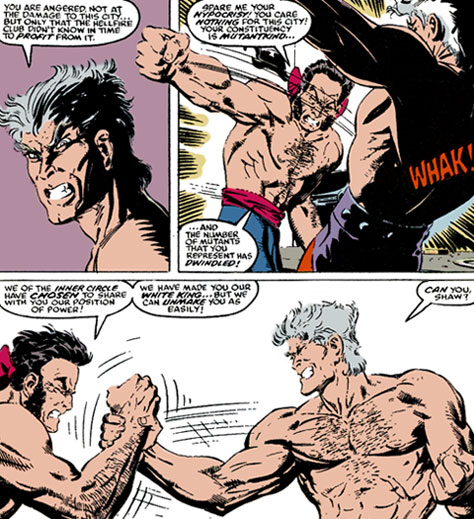 Shaw’s doubts about Magneto’s control over the New Mutants were justified when the machinations of Magneto’s student Magik unleashed the occult invasion known as “the Inferno” on New York City. The dynamic of the Inner Circle quickly began to shift after Shaw summoned them for an emergency meeting. For one, the White Queen began acting unusually courteous toward Magneto, praising him for his past leadership. The implications of this sudden flattery were not lost on Shaw, or on Selene, for that matter, who grew surprisingly defensive of her rival. When it became clear that one of Magneto’s students was partially responsible for the Inferno, Shaw scolded him for failing to control his charges. The Inferno caused an immense amount of property damage to the city, hitting the financial holdings of the Hellfire Club’s members especially hard. Shaw began rethinking his alliance with Magneto in light of these failures. [New Mutants (1st series) #70, 74]
Shaw’s doubts about Magneto’s control over the New Mutants were justified when the machinations of Magneto’s student Magik unleashed the occult invasion known as “the Inferno” on New York City. The dynamic of the Inner Circle quickly began to shift after Shaw summoned them for an emergency meeting. For one, the White Queen began acting unusually courteous toward Magneto, praising him for his past leadership. The implications of this sudden flattery were not lost on Shaw, or on Selene, for that matter, who grew surprisingly defensive of her rival. When it became clear that one of Magneto’s students was partially responsible for the Inferno, Shaw scolded him for failing to control his charges. The Inferno caused an immense amount of property damage to the city, hitting the financial holdings of the Hellfire Club’s members especially hard. Shaw began rethinking his alliance with Magneto in light of these failures. [New Mutants (1st series) #70, 74]
Shortly after that, the Inner Circle received word of strange goings-on at the Xavier School. They arrived to find the building devastated, having been destroyed in an attack. They found the New Mutants at the site, whom Magneto constrained in an iron sphere after they defied him. As Magneto had clearly lost control of both the X-Men, who were believed dead, and the New Mutants, who openly rejected his authority, Shaw argued that Magneto was now worthless to the Hellfire Club and should be expelled. To Shaw’s surprise, Magneto countered by arguing that Shaw’s investments in Sentinel technology were causing immense harm to mutantkind. Although Shaw should have been prepared for such an accurate attack on his investments, he wasn’t, and changed the subject by asserting that there was only room for one of them in the club. 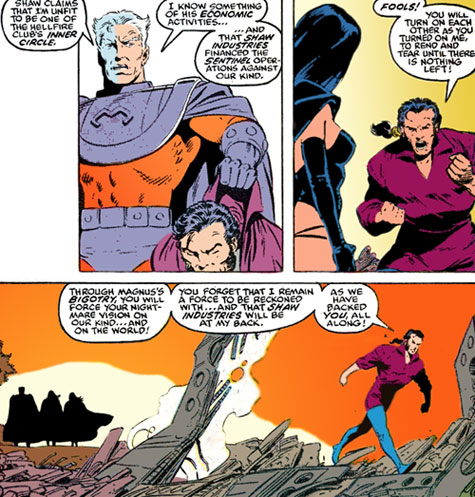 That was his first mistake; his second was putting it to a vote. To Shaw’s surprise, his oldest ally in the club, the White Queen, turned on him, citing his involvement with the Sentinels as a possible cause for the deaths of their allies, Leland and von Roehm. It was Selene of all people who hesitated from ousting him—but the White Queen’s insinuation that Shaw stood in the way of her financial holdings in the Amazon Rainforest convinced her to side against Shaw. Enraged, Shaw left the Hellfire Club, vowing to take the backing of Shaw Industries with him. [New Mutants (1st series) #75]
That was his first mistake; his second was putting it to a vote. To Shaw’s surprise, his oldest ally in the club, the White Queen, turned on him, citing his involvement with the Sentinels as a possible cause for the deaths of their allies, Leland and von Roehm. It was Selene of all people who hesitated from ousting him—but the White Queen’s insinuation that Shaw stood in the way of her financial holdings in the Amazon Rainforest convinced her to side against Shaw. Enraged, Shaw left the Hellfire Club, vowing to take the backing of Shaw Industries with him. [New Mutants (1st series) #75]
Wasting no time, Shaw met with Senator Robert Kelly to ask for funding for a new, enhanced Sentinel project. In Shaw’s opinion, the problem with the Sentinels was that they were designed to attack specific mutants they had on file, and were therefore almost always defeated by unforeseen, unanticipated mutant powers. By the time they built new models to counter these new powers, new mutants bearing new powers would come along to defeat even them. What they needed, Shaw believed, was a Sentinel that could not only learn from its mistakes, but could also potentially reconstitute itself from a single molecule using any available materials. It would have its design written into each molecule like DNA. Incidentally, this vision of the new Sentinel almost perfectly described the Nimrod unit from 80 years in the future—the very model that had recently decimated the Hellfire Club. Shaw made no such connection, though. Senator Kelly, meanwhile, found the idea impressive, but asked Shaw to consider what would happen if such a unit went rogue. If it were made as indestructible and adaptable as he proposed, could it even be contained?
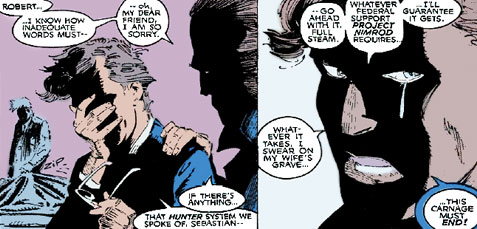 Senator Kelly’s mind changed, however, when his wife, Sharon, died at the hands of a rogue Nimrod unit while it battled the X-Men. Enraged and grieving, Senator Kelly vowed to do whatever he needed to procure federal funding for Shaw’s new Sentinel project—not realizing, of course, that it was one of these Sentinels from the future that killed his wife. Likewise, Shaw failed to realize that the Nimrod unit which attacked him and killed two of his allies would eventually result from technology he was financing in his own era. These inconvenient facts aside, Shaw Industries soon had funding for Project Nimrod. [Uncanny X-Men (1st series) #246-247]
Senator Kelly’s mind changed, however, when his wife, Sharon, died at the hands of a rogue Nimrod unit while it battled the X-Men. Enraged and grieving, Senator Kelly vowed to do whatever he needed to procure federal funding for Shaw’s new Sentinel project—not realizing, of course, that it was one of these Sentinels from the future that killed his wife. Likewise, Shaw failed to realize that the Nimrod unit which attacked him and killed two of his allies would eventually result from technology he was financing in his own era. These inconvenient facts aside, Shaw Industries soon had funding for Project Nimrod. [Uncanny X-Men (1st series) #246-247]
Shortly after being deposed from the Inner Circle, Shaw was approached by a group of villains who, as part of their Acts of Vengeance, were trying to eliminate Spider-Man, who had recently received a cosmic power enhancement. This consortium of villains wanted Shaw to do the job. In return, they promised to eliminate the Lords Cardinal of the Hellfire Club. Obviously this arrangement intrigued the vindictive Shaw. However, when he investigated the men who were hiring him a little deeper, he discovered that one of their members was none other than his usurper Magneto. Shaw concluded that Magneto merely wanted Shaw to go up against the super-powered Spider-Man in order to get himself killed. To avert this without losing the contract, Shaw outsourced the job to the Hulk. The Hulk failed, though, and ended up having to be rescued from certain death by Spider-Man. [Amazing Spider-Man (1st series) #328]
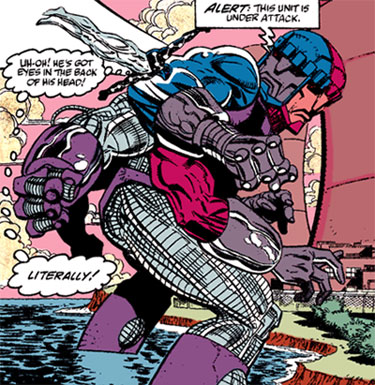 Still determined to eliminate Spider-Man, Shaw assessed the situation and concluded he would first need to strip Spider-Man of his cosmic powers before deploying his Sentinels to finish the job. However, Shaw—after making an understandable error in logic—incorrectly deduced that Spidey’s power-up resulted from an unintended side effect of Dr. Max Lubisch’s experiments with unknown energy fields. Shaw approached the professor and blackmailed him into reverse-engineering a weapon that might undo the effects of Spider-Man’s transformation. Unfortunately, while Shaw was doing this, the Norse trickster Loki fused three of Shaw’s experimental Sentinel prototypes—all part of Project Nimrod—into a single, super-powered Tri-Sentinel. The Tri-Sentinel went live and immediately set out to attack a nuclear power plant in New York City. While Spider-Man was trying to stop it, Shaw and Dr. Lubisch ambushed him with the energy gun, which, to their surprise, had no effect on his powers. Regardless, Shaw continued pursuing Spider-Man and the Tri-Sentinel.
Still determined to eliminate Spider-Man, Shaw assessed the situation and concluded he would first need to strip Spider-Man of his cosmic powers before deploying his Sentinels to finish the job. However, Shaw—after making an understandable error in logic—incorrectly deduced that Spidey’s power-up resulted from an unintended side effect of Dr. Max Lubisch’s experiments with unknown energy fields. Shaw approached the professor and blackmailed him into reverse-engineering a weapon that might undo the effects of Spider-Man’s transformation. Unfortunately, while Shaw was doing this, the Norse trickster Loki fused three of Shaw’s experimental Sentinel prototypes—all part of Project Nimrod—into a single, super-powered Tri-Sentinel. The Tri-Sentinel went live and immediately set out to attack a nuclear power plant in New York City. While Spider-Man was trying to stop it, Shaw and Dr. Lubisch ambushed him with the energy gun, which, to their surprise, had no effect on his powers. Regardless, Shaw continued pursuing Spider-Man and the Tri-Sentinel. 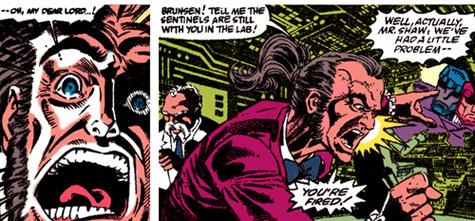 When Shaw realized the Tri-Sentinel was actually composed of his three prototypes—and was threatening to destroy thousands of human lives—he activated an emergency shutdown protocol he had programmed into his Sentinels for situations like this. However, the Tri-Sentinel outsmarted its own programming and continued its assault on the power plant. Just when Shaw accepted that the Tri-Sentinel would likely destroy the plant and kill him alongside thousands of New Yorkers, the cosmically powered Spider-Man destroyed the rogue machine. Shaw breathed a sigh of relief, but took note, as the Sentinel’s defeat likely had ramifications for the Nimrod program. [Amazing Spider-Man (1st series) #329]
When Shaw realized the Tri-Sentinel was actually composed of his three prototypes—and was threatening to destroy thousands of human lives—he activated an emergency shutdown protocol he had programmed into his Sentinels for situations like this. However, the Tri-Sentinel outsmarted its own programming and continued its assault on the power plant. Just when Shaw accepted that the Tri-Sentinel would likely destroy the plant and kill him alongside thousands of New Yorkers, the cosmically powered Spider-Man destroyed the rogue machine. Shaw breathed a sigh of relief, but took note, as the Sentinel’s defeat likely had ramifications for the Nimrod program. [Amazing Spider-Man (1st series) #329]
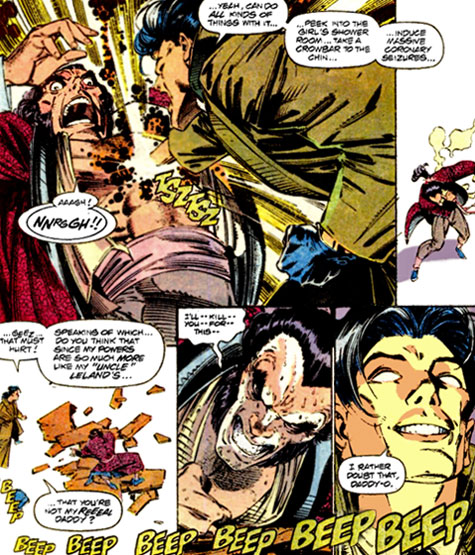 Sometime later, while vacationing at his private Swiss chalet, Shaw learned he had been bought out of his own shares in Shaw Industries. His reaction was a mixture of rage and shock, and he blamed himself for devoting too much of his attention to affairs other than his business. The buyer, it turned out, was his son Shinobi, who then confronted Sebastian and gleefully mocked his fall from glory. Enraged, Shaw threatened his defiant son and told him he’d rather see him dead than lose control of the firm he worked his whole life to build. At that point, Shinobi informed his father that his own mutant power—altering his body’s molecular density—had recently activated, and allowed him to do such things as induce coronaries in other people. He then gave his father one such coronary. Adding insult to injury, Shinobi hinted to his dying father that perhaps his power to alter density hadn’t come from Shaw at all, but from his “Uncle” Leland. With his dying breath, Shaw vowed he would kill Shinobi for this betrayal—a prospect Shinobi highly doubted. Shinobi then blew up the entire chalet with both him and Sebastian inside, only to then emerge from the rubble unharmed and declare that his father had been “fired.” [X-Factor (1st series) #67]
Sometime later, while vacationing at his private Swiss chalet, Shaw learned he had been bought out of his own shares in Shaw Industries. His reaction was a mixture of rage and shock, and he blamed himself for devoting too much of his attention to affairs other than his business. The buyer, it turned out, was his son Shinobi, who then confronted Sebastian and gleefully mocked his fall from glory. Enraged, Shaw threatened his defiant son and told him he’d rather see him dead than lose control of the firm he worked his whole life to build. At that point, Shinobi informed his father that his own mutant power—altering his body’s molecular density—had recently activated, and allowed him to do such things as induce coronaries in other people. He then gave his father one such coronary. Adding insult to injury, Shinobi hinted to his dying father that perhaps his power to alter density hadn’t come from Shaw at all, but from his “Uncle” Leland. With his dying breath, Shaw vowed he would kill Shinobi for this betrayal—a prospect Shinobi highly doubted. Shinobi then blew up the entire chalet with both him and Sebastian inside, only to then emerge from the rubble unharmed and declare that his father had been “fired.” [X-Factor (1st series) #67]
